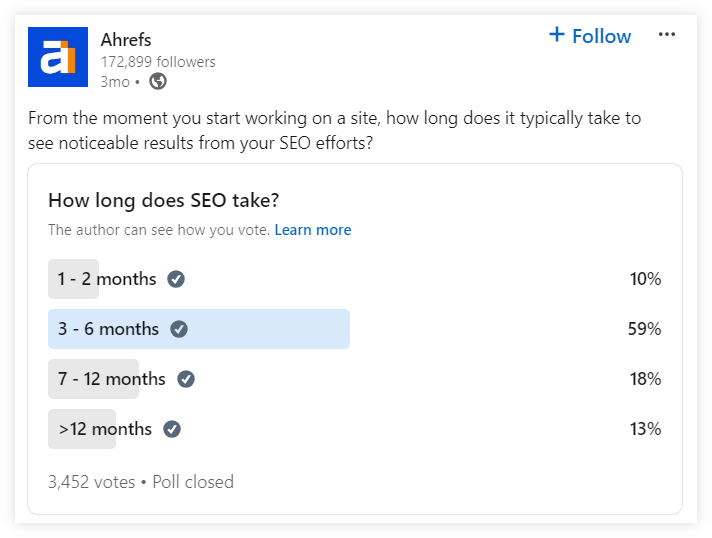Understanding the timeline and setting realistic expectations is crucial in measuring the success of your SEO efforts.
When optimizing your website for search engines like Google, you might be wondering: When will I see results from my SEO efforts?
In this article, we will therefore take a look at:
- How long does SEO take?
- Why does SEO take so long?
- Factors that impact SEO results
- Practical SEO timeline
- How to get SEO results faster?
How long does SEO take?
SEO can take between 3 to 6 months to start showing results, depending on the scope of the SEO efforts undertaken on the website.
However, this timeframe can fluctuate based on the specific circumstances of each project; for some websites, it can take as long as a year.
SEO is not a one-size-fits-all strategy, and its effectiveness can vary greatly depending on a multitude of factors, such as your SEO strategy, on-page issues, content quality, or even Google’s algorithm updates, which may accelerate or slow down the website’s rankings.
According to a study by Nectafy, it can take up to a year for new websites to see positive results in terms of organic traffic and rankings.
However, if your website has been around for a bit longer, the results may start showing up much sooner.
Based on Ahrefs’ simple data pool, most website owners and SEO specialists began to see noticeable results from their SEO efforts somewhere between 3 to 6 months.

Why does SEO take so long?
Unlike other digital marketing tactics that can drive immediate traffic, SEO is a gradual process built on consistency and persistence.
This is because SEO is not just about making a single change but about continually enhancing and refining your website to meet the best practices of search engine algorithms.
This includes proving to Google and other search engines that your site is a credible, authoritative source of information and that it deserves a spot at the top of search results.
From a practical standpoint, there are a few technical aspects, such as crawling/indexing processes, ranking algorithms, or website quality, that may dramatically affect your SEO timeline.
According to John Mueller (Google Search Advocate), even unwanted server overloads or bad interlinking may influence how fast your website will start ranking in Google Search.
Let’s now take a look at the practical reasons why your SEO efforts may take so long to deliver actual results.
1. SEO goals and KPIs
Setting clear SEO goals and key performance indicators (KPIs) is key to measuring the success of your SEO efforts.
However, the specific goals you set can significantly impact how quickly you see results:
- For some, the goal might be to rank a single blog post in the top search results, which can be quicker to achieve if the competition is low. For others, the aim might be to dominate a competitive industry niche, which naturally takes longer due to the intense competition and established presence of existing leaders.
- Different KPIs can take varying amounts of time to improve. Simple metrics like increased rankings for specific low-competition keywords might be noticed within a few months, whereas more complex goals like significant increases in conversions or overall traffic growth can take longer and require more sustained effort.
Understanding that each goal and KPI has its own timeline can help set realistic expectations for the SEO process.
2. SEO strategy
The strategies you employ in your SEO campaign also dictate the time frame for seeing results.
For example, broad, aggressive strategies covering a range of SEO activities — from on-page optimization to aggressive link building and large-scale content creation — might yield bigger results but require more resources.
On the other hand, a more conservative approach, focusing on gradual enhancements and limited keyword targets, might take longer to show results but could be more sustainable in the long run.
It simply depends on your SEO strategy and approach – no matter which way you decide to go, it will always take some time to deliver actual results.
Or as Maile Ohye (Former Developer Programs Tech Lead at Google) stated:
“In most cases, SEOs need four months to a year to help your business first implement improvements and then see potential benefit.”
3. Website history
The historical performance and the existing state of your website influence how quickly you can see SEO results.
Older domains that have built credibility and a clean, penalty-free history with search engines tend to perform better in SEO efforts more quickly than newer sites starting from scratch:
“If your website is just, let’s say, a couple of months old, maybe 8 months, maybe a year, then that’s still very, very fresh, with regards to the resort of the internet. So, that’s kind of a time where our algorithms are still trying to figure out how and where we should show your website in the search results overall” (John Mueller, Google Search Advocate).
The same is true of current SEO health.
Websites that rank fairly well for some keywords or have a good content foundation can see quicker improvements than sites that lack SEO groundwork.
If previous SEO efforts were implemented correctly and ethically, you might see faster progress.
However, if your site has been penalized for black-hat techniques in the past or suffers from technical debts and poor content quality, rectifying these issues can add significant time to your SEO timeline.
4. Resources for SEO
The resources allocated to your SEO efforts are a fundamental factor in how quickly you can see results.
For example, if you have a larger budget, you will be able to access more comprehensive content creation, more extensive link-building campaigns, and more experienced SEO professionals.
Investing in the right SEO tools (such as our Mangools SEO suite 😉) can make a significant difference.
5. Competition in Google Search
Competition in Google Search is another major factor that can extend the timeline for seeing SEO results.
The level of competition can vary widely from one industry to another or even among different keywords within the same industry.
Understanding your “share of search“—the percentage of all branded searches—can provide valuable insights into your competitive position.
A low share of search indicates more room for growth but also suggests that achieving visibility will require more effort and time due to high competition.
In highly saturated markets, where many businesses compete for the same keywords, it can take longer to see significant movement in search rankings.
In these cases, focusing on niche markets or specific long-tail keywords may provide quicker results.
6 factors that impact SEO results
Understanding the factors that influence the effectiveness of your SEO efforts can help you optimize your strategies and set realistic expectations for outcomes.
Here’s a closer look at some critical aspects that play a significant role in determining how long it may take to see results from your SEO activities.
1. Crawling and indexing
Before your website can start ranking, search engines need to discover, crawl, and index your pages.
This process requires two main steps:
- Efficient crawling: Ensure that search engine bots can easily access and crawl your site. This means having a clean, fast-loading site structure, a well-organized sitemap, and no misplaced no-index tags that could hide your site from search engines.
- Quick indexing: After crawling, search engines index your content, storing information about your pages in their databases. Employing tools like Google’s URL Inspection or Submit to Index feature in Google Search Console can expedite this process, especially for new or significantly updated pages.
2. Content quality
Search engines want to provide users with the best possible results, which means that only the highest-quality content makes it to the top of the SERPs.
Quality content should not only be relevant to the user’s search query but also provide comprehensive information that addresses the user’s needs.
Content that skims the surface without providing depth can struggle to rank well.
Search engines are also sophisticated enough to distinguish valuable content from fluff. Every piece of your content should aim to provide clear, concise, and useful information to your audience without unnecessary filler.
Finally, Google emphasizes the importance of E-E-A-T (Experience, Expertise, Authoritativeness, Trustworthiness) in its search quality guidelines.
Content that demonstrates real-world experience and expertise in a subject matter tends to rank higher. This means having qualified authors or proven expertise in your content’s subject area is crucial.
3. On-page SEO
On-page SEO is a critical factor because it directly controls how your site communicates with search engines.
Here are some things that impact on-page SEO:
- Keyword optimization: Properly incorporating relevant keywords into titles, headings, and throughout the content helps search engines understand what the page is about and match it to appropriate search queries.
- Title tags and meta descriptions: Well-title meta tags and descriptions can improve click-through rates from the search results page. They should be engaging and include targeted keywords.
- URL structure: Clean, descriptive URLs that include keywords can provide a better user experience and help with rankings. Avoid long, cryptic URL strings.
- Site speed: Fast-loading pages are crucial for good SEO. Search engines favor websites that provide a good user experience, and speed is a significant factor.
- Mobile-friendliness: With mobile-first indexing, ensuring your website is optimized for mobile devices is more important than ever. A responsive design adjusts content to fit different screen sizes, improving usability and SEO.
4. Domain age
Domains previously associated with authoritative sites or that have a history of publishing high-quality content may have an easier time ranking.
Past penalties also impact SEO. If a domain has been penalized in the past for black-hat SEO tactics, it might take longer to recover and rank well, even with a clean SEO strategy moving forward.
Another way to look at domain age as a factor is the actual time since the website within the domain was established.
Or as Matt Cuttrs (former Google software engineer) explained:
“A good way to think about it (the domain age) is often the vast majority of the time, we will have coverage for when we first crawled a domain or when we first saw a link to a domain.”
5. Backlink profile
Backlinks — links from other websites to your site — are essential for SEO.
They act as endorsements, signaling to search engines that other websites vouch for your content.
However, keep in mind that while a strong backlink profile with links from reputable sites in your industry can dramatically improve your rankings, links from spammy or irrelevant sites can harm your SEO.
Ideally, links should be coming from different domains, including blogs, news sites, and business directories to enhance your SEO efforts.
6. Current state of the website
The current technical and content state of your website plays a vital role in how quickly you can see SEO results.
For example, websites with minimal technical issues — such as broken links, unoptimized images, or slow servers — can focus more on content and user experience, which are more impactful for SEO.
SEO timeline
Mapping out an SEO timeline is a great way to set realistic expectations so you can monitor progress throughout your campaign.
Let’s break down what typically happens month by month in a comprehensive SEO strategy.
Month 1
The first month is extremely important, as it sets the foundation for all SEO activities that follow.
Here’s a breakdown of what you should expect during the first month of your SEO campaign, whether you’re working with an agency or managing SEO in-house:
- Keyword research and keyword mapping – One of the first tasks in any SEO strategy is to conduct thorough keyword research to help you guide your content creation and on-page optimization efforts. This step involves identifying the keywords that your target audience is searching for.
- Technical and on-page SEO audit – A comprehensive technical SEO audit is crucial to uncover any underlying issues that could affect your site’s performance in search engines. This audit will assess aspects such as site speed, mobile-friendliness, URL structure, and internal linking strategy.
- Keyword and content planning – Armed with a list of targeted keywords, the next step is to plan your content strategy. This involves deciding what type of content to create, who the target audience is, and how your content can solve their problems or answer their questions.
- Setting up KPIs – What gets measured gets managed. Setting up Key Performance Indicators (KPIs) is essential for tracking the success of your SEO efforts. Common KPIs include organic traffic, rankings, backlinks, and conversion rates.
Month 2
As the second month of your SEO strategy unfolds, the focus shifts to deepening the efforts from the first month.
This period is crucial for implementing changes that can significantly impact your website’s performance in search rankings.
The tasks for this month involve more technical SEO adjustments, improving user experience, and ramping up content creation.
- Fixing on-page issues – Based on the initial audit from month one, the second month often involves making specific on-page optimizations. This includes adjusting meta tags, fixing broken links, optimizing image alt attributes, and ensuring that all title tags are effectively written and include main keywords.
- Enhancing user experience (UX) and user interface (UI) – Improving the UX and UI is essential not just for SEO but for overall user satisfaction. If your site isn’t responsive, elements like buttons, images, and navigation can become distorted, which negatively impacts usability and, consequently, SEO performance.
- Content development – While ongoing, the creation of strategic content often kicks into higher gear during the second month. Content developed based on keyword research and planning from the first month is crafted, optimized, and published. The content strategy could include blog posts, long-form articles, infographics, or videos, depending on your audience’s preferences and your industry.
- Technical SEO enhancements – The second month is also when more in-depth technical SEO work begins. This might include enhancing site navigation, implementing schema markup to improve search engine clarity, and optimizing server response times.
If the site requires a major overhaul—perhaps due to outdated architecture or because it was acquired from another owner—this work might extend beyond the second month.
Month 3
The foundational work of previous months should start to show results by the third month of your SEO campaign.
This phase is crucial as it focuses on content development, enhancement of user experience (UX), and beginning active content promotion and link-building efforts.
Refining keyword selection: Now it’s time to refine that long list of potential keywords down to those most strategic for targeting.
Selecting the right mix of these keywords is extremely important. Long-tail keywords, for instance, while less competitive, can effectively attract the precise audience that’s likely to convert, making them invaluable for targeted SEO strategies.
Content creation and implementation: With the targeted keywords determined, the real magic of content creation begins. The type of content produced can vary significantly depending on the chosen keywords:
- Long-form content: Articles exceeding 2000 words are valuable for SEO. They are known to generate higher organic traffic, more social shares, and increased backlinks.
- Blog content: Regularly updated blogs are essential for keeping your website fresh and engaging.
- Product and service descriptions: Detailed descriptions of your offerings not only help in selling your products but are also crucial for ranking those specific pages in search engines.
Publishing and promotion: Once the content is created, it’s time to publish and promote it. This stage is critical as even the best content can only perform if it’s seen. Link-building and content promotion efforts begin earnestly during this month to increase visibility.
Tracking progress: As the new content goes live, it starts getting indexed by Google. While you may not see immediate placement in top search results, well-optimized content will begin to climb the ranks. By the end of the third month, you should start seeing significant movements in your SEO metrics.
Month 4
This is a critical time for analyzing outcomes, making necessary adjustments, and intensifying certain activities to ensure continued improvement in your website’s performance.
Tracking and analyzing initial results: By month four, the changes made in the earlier months should start showing through increased site traffic and better search engine rankings. Key performance indicators (KPIs) like page rankings, organic traffic, bounce rate, and conversion rates are crucial metrics to monitor. Tools like Google Analytics and Google Search Console provide invaluable insights that help track these metrics.
Making adjustments and technical optimizations: Based on the data gathered, small on-page adjustments might be necessary to enhance content performance and user engagement. These could include tweaking meta descriptions to increase click-through rates, adjusting header tags for better keyword focus, or refining internal linking strategies to boost page authority.
Intensifying Link-Building Efforts: High-authority backlinks are a testament to the credibility of your content and are highly regarded by search engines like Google. Your marketing team or SEO agency might increase efforts to reach out to reputable sites within your industry for guest blogging opportunities, shared studies, or collaborative content, all of which can lead to natural and valuable link-building.
Implementing A/B testing: A/B testing becomes an integral part of this month’s activities. Testing different versions of your web pages can help determine what layouts, calls to action, and content types most effectively drive user engagement and conversions. A/B testing provides concrete data that can be used to make informed decisions about future content and design changes.
Month 5
As you approach the half-year mark in your SEO campaign, month five becomes a period of significant assessment and strategic planning.
It’s a time when the initial results of your efforts should be clearly visible, providing a solid basis for evaluating the effectiveness of your strategies and setting the stage for further optimization.
Evaluating key performance indicators (KPIs): By now, you should see an uptick in site traffic and potentially an increase in conversions or sales. This month is crucial for a comprehensive evaluation of all KPIs, including organic search traffic, bounce rate, conversion rate, and SERP rankings.
Analyzing current results: Your SEO team should employ advanced tools like Google Analytics to gather data and insights on how your campaign is performing. This analysis will help pinpoint which SEO tactics are driving results and which areas may need more adjustment or enhancement.
Preparing new SEO campaigns and strategies: With solid data in hand, this month is also about forward planning. Based on the outcomes and learnings from the initial months, your SEO team will start preparing new campaigns and refining existing strategies to capitalize on what’s working.
SEO and social media integration: If not already in place, integrating your social media marketing with your SEO strategy becomes essential. Social signals are increasingly relevant to SEO, as they reflect genuine user engagement and interest. Your SEO agency might collaborate with a social media marketing agency to ensure that your brand’s social profiles are optimized and effectively contributing to your SEO goals.
Expanding content and A/B testing: Continuing to produce high-quality content is vital. Additionally, you should now be using A/B testing to optimize web page elements further, such as CTAs, page layouts, or even meta tags.
How to get SEO results faster?
While SEO is a long-term strategy, there are effective tactics you can employ to potentially speed up the process.
1. Speed up crawling and indexing
To get search engines to notice changes to your site and adjust your rankings sooner, focus on enhancing how they crawl and index your content.
You can do this by submitting a sitemap through Google Search Console, using Google’s URL Inspection tool to submit individual URLs for crawling, and taking advantage of proper interlinking (where new content is linked from important, relevant pages).
You should also block unnecessary URLs to prevent search engines from wasting time crawling irrelevant or duplicate pages and make sure that your web hosting can handle the load, especially when search engines are crawling your site. If your server goes down during a crawl, it could delay indexing.
Monitoring your site’s uptime is crucial, not just for user experience but also for SEO.
If search engines consistently find your site unreachable, it could negatively impact your rankings.
Services such as UptimeRobot can provide real-time alerts when your site goes down, allowing you to address any issues promptly.
2. Focus on long-tail keywords
One of the most effective strategies to speed up the SEO process is to focus on long-tail keywords.
These keywords are more specific and usually longer than more commonly searched keywords.
By targeting these, you can not only improve your chances of ranking quicker but also attract more qualified traffic to your site.
Long-tail keywords can be a game-changer in your SEO efforts because they have relatively lower competition in search results.
These keywords are easier to rank for because fewer websites are targeting them, making them a strategic choice for new or smaller websites looking to gain visibility.
3. Create high-quality content
To climb to the top of search engine results pages (SERPs), your content must be superior in several key areas, which means:
- The content is relevant: Your web pages must align closely with the intent behind users’ searches. This means understanding the problems, questions or needs that bring users to your page and providing clear, direct solutions or answers.
- The content enhances user experience: This includes optimizing the layout for readability, making navigation intuitive, and ensuring your site is mobile-friendly.
- The content is high quality: Every piece of content should aim to add value in a way that resonates with and benefits the reader. This could be through detailed how-to guides, insightful analysis, entertaining narratives, or comprehensive resources that go beyond the superficial treatment of a topic.
- The content is original: This means offering new perspectives on topics, presenting original research or data, and crafting content that cannot be found elsewhere.
- The content reflects genuine expertise and authority in your field: This means having content created by knowledgeable authors or ensuring thorough fact-checking and referencing for all informational content. Demonstrating expertise is particularly important in fields covered by Google’s E-E-A-T guidelines (Experience, Expertise, Authoritativeness, and Trustworthiness), such as healthcare and finance.
- The content is refreshed regularly: Even the best content can become outdated. Regularly refreshing your content ensures it remains relevant and continues to meet the user’s needs.
4. Fix technical and on-page errors ASAP
Effective SEO is not just about adding new strategies but also about refining what already exists on your website.
This involves addressing any technical SEO issues swiftly and improving or eliminating unhelpful content.
If search engines like Google can’t crawl and index your pages correctly, no amount of content optimization or link building will help.
Common technical SEO errors include:
- Crawl errors
- Broken links
- Improper use of tags
In addition, you should also improve (or delete) unhelpful content. Google’s guidance is clear: content that doesn’t help users can negatively impact your site’s overall ranking.
Conducting a content audit will help you identify which pieces of content are underperforming or damaging your SEO efforts.
5. Boost your online presence
Expanding your online presence and share of voice beyond your website can significantly impact your SEO results.
You can do so by investing in Pay-Per-Click (PPC) advertising to bring immediate traffic to your site, engaging with your audience on social media platforms where they are most active, and regularly visiting forums and community boards.
Forums like Reddit, Quora, and industry-specific boards allow you to answer questions, provide value, and subtly link back to your website’s content where relevant.
6. Improve your backlink profile
Backlinks from reputable sites signal to search engines that your content is credible and authoritative, which can significantly boost your rankings.
Guest blogging is a great way to improve your backlink profile, but you need to choose sites with high domain authority to get the most SEO benefit.
You could also collaborate with other brands or influencers in your field for joint marketing initiatives (this can lead to natural and high-quality backlinks) and you should make sure that your business is listed in respected directories and business listings.
7. Create new content consistently
New content not only keeps your website fresh and engaging for repeat visitors but also provides more opportunities for ranking in search engines.
Content creation tips:
- Develop a content calendar to plan and schedule your posts effectively.
- Include a mix of content types such as blogs, videos, infographics, and podcasts.
- Make sure that each piece of content is optimized for SEO with targeted keywords, meta descriptions, and engaging titles.
8. Track your KPIs on a regular basis
As your SEO strategies mature and evolve, it’s crucial to continuously measure their effectiveness.
Tracking the right Key Performance Indicators (KPIs) will not only show you how well your SEO efforts are performing but also help pinpoint areas that need further optimization.
KPIs to focus on:
- Organic traffic: An increase in organic traffic generally indicates that your SEO strategies are effective. Tools like Google Analytics can provide detailed reports on your organic traffic, including trends over time and traffic sources.
- Click-Through Rate (CTR): This measures how often people who view your website in search engine results end up clicking on it. A low CTR might indicate that your meta titles and descriptions are not compelling enough or not aligned with search intent.
- Website rankings: It is essential to track where your keywords rank in search engine results pages (SERPs). Improvements in rankings can lead to increased traffic and visibility.
- Number of backlinks and referring domains: More high-quality backlinks from diverse referring domains suggest that your content is considered authoritative and trustworthy.
- Conversions: Ultimately, the goal of SEO is not just to attract traffic but to convert that traffic into leads, sales, or other desired actions. Set up goals in Google Analytics to track how well your organic traffic converts.
Regular monitoring allows you to see trends and make data-driven decisions.
For example, if you notice a sudden drop in organic traffic or rankings, it could indicate a potential issue such as a penalty or an algorithm update that needs to be addressed.
Remember, SEO is not a quick fix but a strategic endeavor that builds momentum over time.
Final words
Consistency and persistence are key in SEO.
Ultimately, a well-planned SEO strategy, backed by a deep understanding of your business objectives and audience needs, will not only improve your search engine rankings but also drive meaningful traffic and increase conversions, contributing to long-term business growth.
Remember, the journey to SEO success is ongoing, and staying committed to best practices and continual learning is essential.






